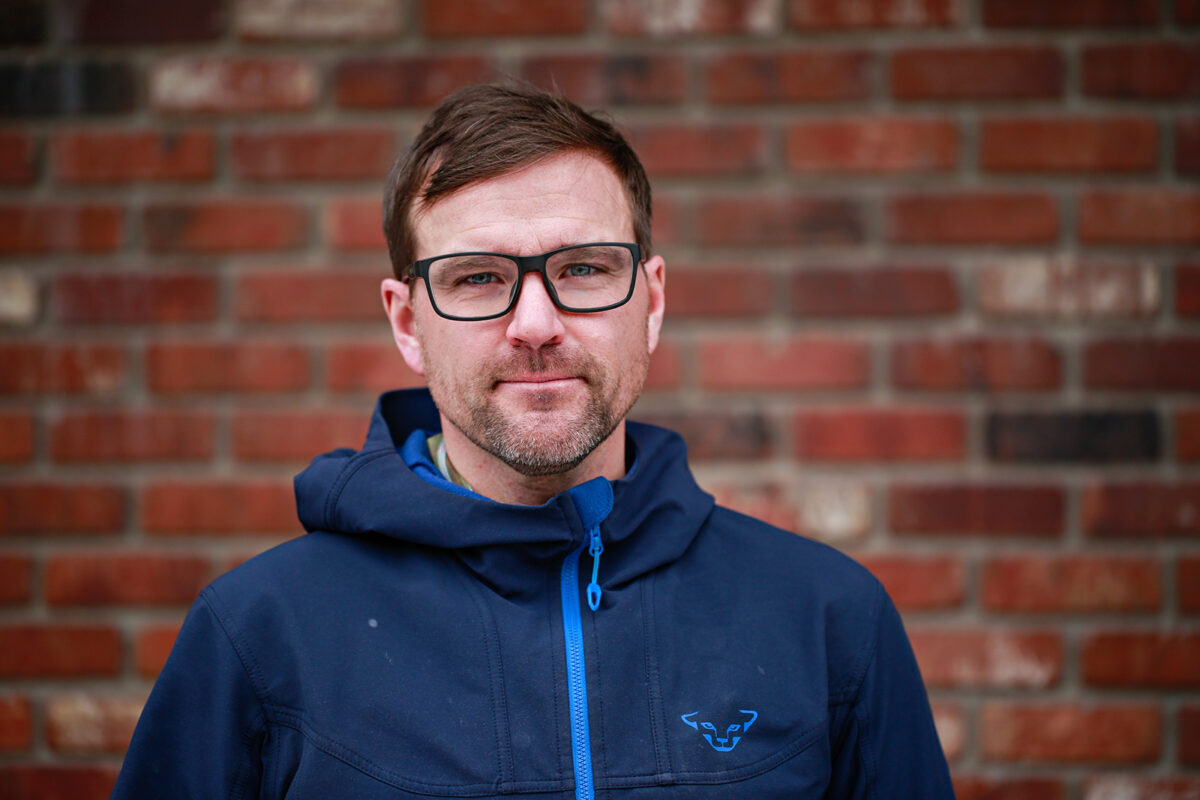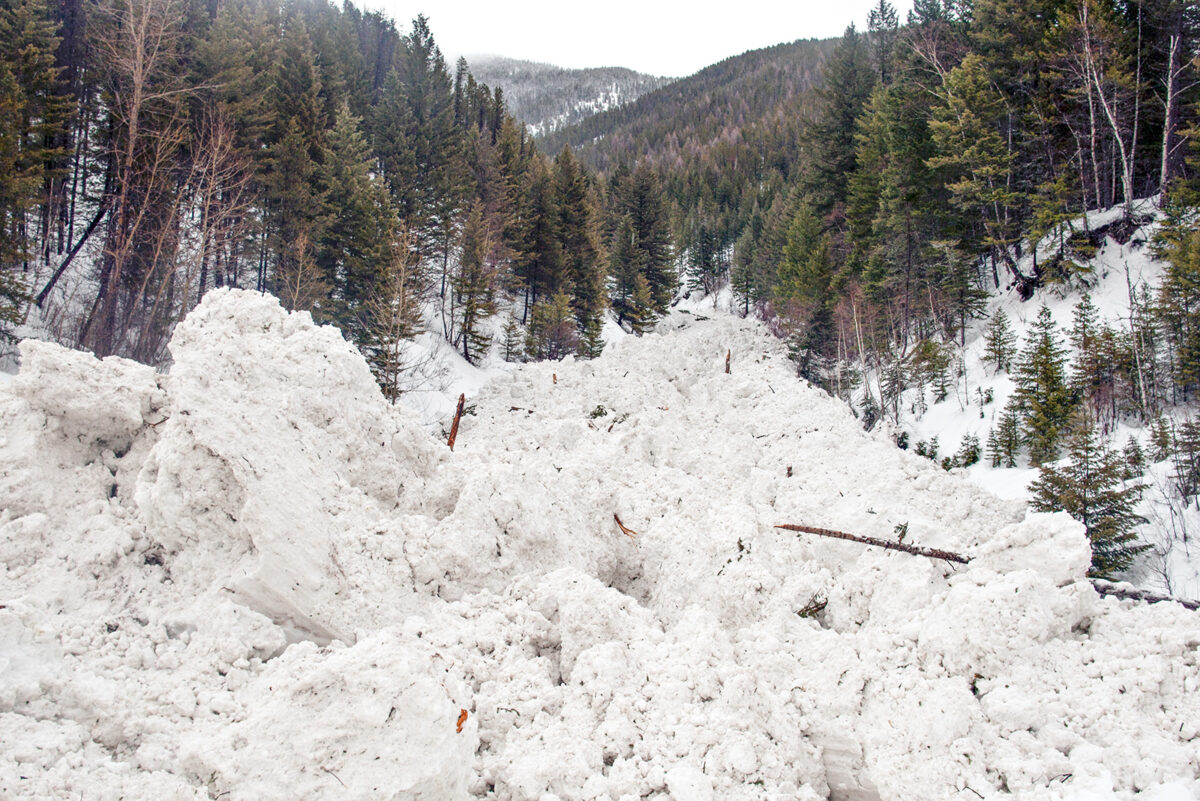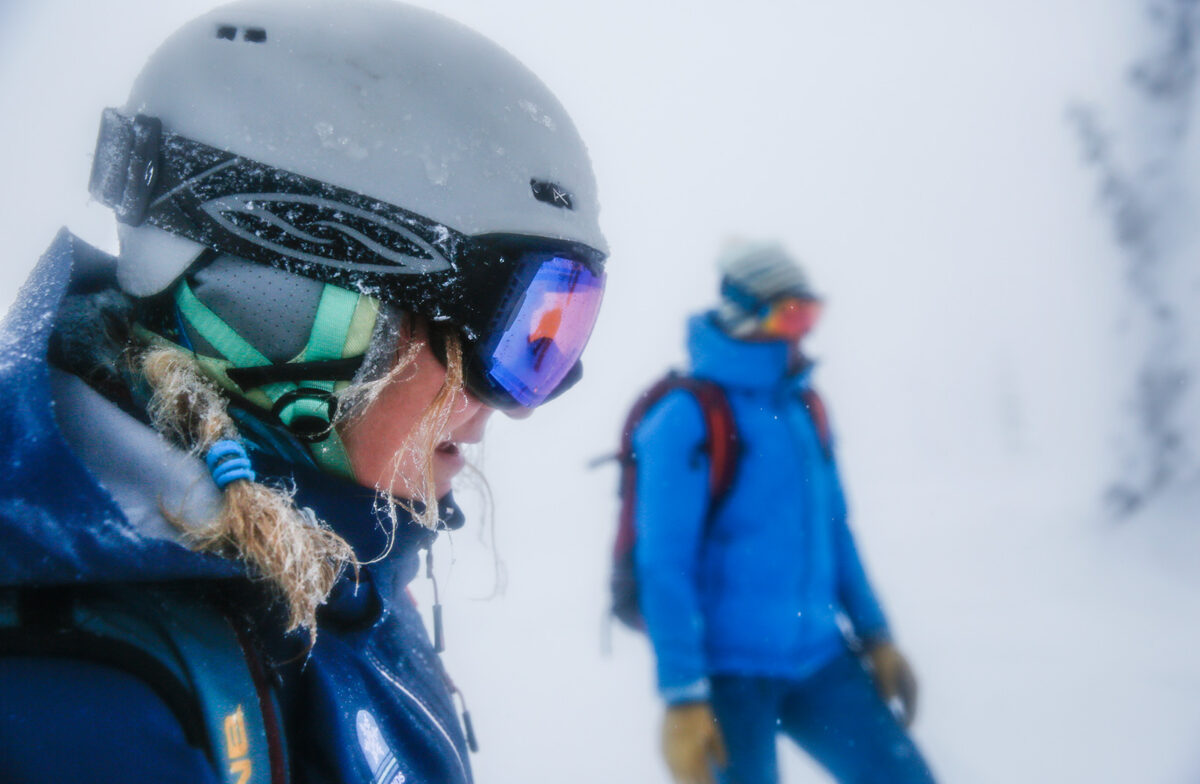A Model Avalanche Center
Flathead Avalanche is celebrating its 10th anniversary this winter with more forecasters, events and educational programming than ever before as snow safety advocates reflect on its evolution that began in the Flathead Valley more than four decades ago
By Maggie Dresser
When Erich Peitzsch was hired as the director of the freshly rebranded Flathead Avalanche Center (FAC) for the 2013-2014 winter season, he was a part-time staff member covering a forecast region of more than 1 million acres in northwest Montana. While he was gathering data from the Flathead, Swan and Whitefish ranges and Glacier National Park and issuing avalanche advisories, he was also teaching courses and working to engage the public about avalanche safety.
Peitzsch was hired as an interim director for that inaugural season while the search for a long-term director continued. At the time, he was already working in a full-time position at the U.S. Geological Survey’s (USGS) Northern Rocky Mountain Science Center as a physical scientist while laying plans to earn a PhD in snow science.
Stepping into his new role, Peitzsch was tasked with directing a new Type 3 Avalanche Center, producing roughly three advisories per week while also working with the FAC’s new nonprofit partner, Friends of the Flathead Avalanche Center (FOFAC).
“It was so hard,” Peitzsch said. “It was hard because even though we put out three advisories a week, it’s a seven-day a week job. You don’t know when conditions are going to change.”
In that first year, Peitzsch had help from part-time forecasters Todd Hannan and Seth Carbonari and he worked with a $53,000 budget funded by federal dollars and grants, according to the FAC 2013-2014 annual report.
But the FAC and FOFAC – the two-pronged organizations that fall under the umbrella of Flathead Avalanche – have come a long way as the center celebrates its 10-year anniversary this season.
Having graduated to the top-tier status as a Type 1 Avalanche Center, there are now five full-time avalanche forecasters under the leadership of FAC Director Blase Reardon that produce daily advisories from December through April. FOFAC Executive Director Emily Struss has tripled her staff in recent years while delivering a steady stream of avalanche education throughout the winter. She’s also facilitated the installation of five new weather stations in the forecast region, and she’s helped grow the annual budget to more than $300,000 in fundraising dollars and federal money.
“Now, it’s a model avalanche center,” Peitzsch said.
As the staff and board members reflect on this decade-long milestone this winter, they also recognize the era of avalanche forecasting that existed in northwest Montana before Flathead Avalanche officially launched at the end of 2013.
Before Flathead Avalanche became a model center, the region’s avalanche forecasting history dates back to the late 1970s, which started with a few Flathead National Forest (FNF) and Glacier National Park (GNP) employees who were dedicated to avalanche safety before it became the norm in the western United States.

For years, local snow safety professional Ted Steiner remembers hearing avalanche warning messages on the radio after he moved to Whitefish in the 1980s. The broadcasts were one of a few limited ways that forecasters with the FNF were able to reach the public to present the current avalanche conditions and to inform the backcountry-safety decisions of Flathead Valley residents.
These warnings, which illustrated the present and future avalanche hazards in the backcountry, were delivered by government officials through the Northwest Montana Avalanche Warning System (NMAWS). Launching in 1979, the 70-second warnings were issued Friday mornings on “NOAA Weather Radio,” broadcast stations and they were also printed in local newspapers. Modeled after a similar system that had been recently established in Colorado, this was the only avalanche advisory outreach method in the Flathead Valley at the time.
“I remember when I was younger hearing warnings that came out on the radio,” Steiner said. “Apparently, these guys had a transmitting station on Big Mountain and the idea was they put out a message to the public when conditions were ramping up.”
FNF employee Cal Tassinari helped implement the NMAWS as a partnership between GNP, the U.S. Forest Service and the National Weather Service (NWS). With help from government staff members Bob Frauson, Dave Panebaker, Al Bratkovich and Gerry Osborne, they compiled data from GNP and the Swan River, Libby and Whitefish regions, according to newspaper archives. From the Tally Lake Ranger District, Tassinari began releasing the Friday advisories that December.
In addition to the advisories, Tassinari also taught avalanche courses at Flathead Valley Community College (FVCC) and continued educating recreationists after his retirement from the U.S. Forest Service in the 1980s.
Steiner, who now works as an avalanche safety contractor for BNSF Railway and serves as the FOFAC Board President, said he remembers Tassinari in those days.
“I moved to the valley in 1983 and some of my first avalanche instruction and education was with Cal Tassinari,” Steiner said. “I certainly consider him a mentor.”
After Tassinari’s retirement in 1983, Kim Potter took over his position and was eventually succeeded by Stan Bones, a U.S. Forest Service engineer who oversaw the program and continued issuing advisories for the next couple decades.

In 1989, Bones helped start an avalanche hotline as part of a partnership between local government organizations, Big Mountain, and Rocky Mountain Outfitter owner Don Scharfe, a local skier who was eager to continue growing the avalanche advisory program.
As avalanche centers in more populated areas like Colorado and Utah grew, Scharfe hosted a meeting in 1995 at his shop in downtown Kalispell with Bones and other local stakeholders to brainstorm ways to do the same in the Flathead Valley. Fundraising was their primary goal, which was meant to supplement the Forest Service’s limited budget.
“Stan was in a position of trying to do what he could with limited time and money,” Reardon said. “We brought in the model of a nonprofit – I saw that in Utah with Friends of the Utah Avalanche Center – and we got that going.”
The evolution of highway avalanche programs and large-scale avalanche incidents at the time helped trigger avalanche center growth, Reardon said. The 1993 Peters Ridge avalanche was one of those incidents, which claimed the lives of five snowmobilers, including a 7-year-old boy, in the Swan Range on New Year’s Eve.
Reardon – FAC’s current director – was involved in those conversations early on and said they led to the formation of Glacier Country Avalanche Center, Inc., a fundraising and education organization that provided some extra financial support. The U.S. Forest Service also began calling its avalanche program the Glacier Country Avalanche Center (GCAC). Three years later, the organization was recognized as a 501(c)(3) nonprofit and raised enough money to hire Reardon as a second forecaster to help Bones.
“Since the 90s when it started, there has been tremendous changes in the industry,” Reardon said. “A lot of public backcountry forecasters gained momentum.”
Now that a nonprofit arm was attached to GCAC, a board of directors was established while fundraising and education outreach extended throughout the Flathead Valley. Reardon and Bones issued weekly advisories over the next couple years and continued working with a small budget.
As the industry grew, Steiner took over as the nonprofit’s executive director in 2000, introducing GCAC to the world wide web by creating a site where the advisories were posted, and which soon reached more people than the hotline.
But by the new millennium, the FNF administration made some budget cuts.
To save money, the Forest Service eliminated seasonal positions – including Reardon’s – and he was replaced with a permanent FNF employee with minimal avalanche experience. While GCAC carried on after the budget cut, the relationship between the nonprofit and the Forest Service soured after Reardon was replaced and the board shifted their focus to education.
Despite the tension, Bones continued issuing advisories over the years while many of the folks involved with GCAC’s creation moved on. Reardon took a job with USGS and started the Going-to-the-Sun Road avalanche program in Glacier Park, whereas Steiner left the board and started working as an avalanche safety contractor for BNSF Railway.
GCAC and the board were still operating, but local recreationists didn’t believe it was living up to its potential.
In 2012, A new crop of skiers met at FNF Recreational Specialist Becky Smith-Powell’s home in Whitefish to formulate a plan to revamp the avalanche center and create a stronger partnership. Working together with the remaining three GCAC board members, new stakeholders like the Flathead Snowmobile Association, and the recently hired FNF Supervisor Chip Weber, the new guard of avalanche education cut ties with the organization and started fresh.

“We really didn’t have a choice,” Smith-Powell said. “GCAC had stepped back from fundraising, and it wasn’t functioning very well.”
As a FNF employee, Smith-Powell already had experience partnering with nonprofit organizations and after writing successful grants, the avalanche center was awarded more than $30,000 that first year to help fund avalanche education and advisories. With additional money from the new organizer’s own pockets, they hired a lawyer to finalize the 501(c)(3) paperwork that would become FOFAC. From there, Flathead Avalanche was born.
“I had a unique situation in that I could lead the team and explain what a good partnership was – and they actually listened,” Smith-Powell said. “It was great.”
A new board of directors was established to run FOFAC, including Smith-Powell’s husband Dow, Roland Frey and Whitefish Mountain Resort ski patrollers Jenny Cloutier, Lloyd Morsett and Mike Block, who became the board president. Smith-Powell acted as the program manager with the FNF while also sitting on the board as a non-voting member.
Following the transition, the board chose Peitzsch to lead FAC as the interim director along with Hannan – who both worked part time – along with additional support from observers. The forecasters began issuing advisories three times per week, making it a Type 3 Avalanche Center in its first season before graduating to a Type 1 center, issuing daily advisories, the following year.
“Hiring Erich Peitzsch was pivotal in bringing us to a Type 1 center,” Cloutier said.
Cloutier became the FOFAC education coordinator, working on a part-time basis for the next five winters to teach safety courses and provided avalanche outreach. Over the years, she worked to expand programming with introductory courses, avalanche awareness talks, partnerships with FVCC, and she helped facilitate the nonprofit’s entry into the Great Fish Community Challenge.
After leaving her position at the end of the 2019 season, Cloutier transitioned to the board of directors and now sits as the vice president, passing the education-coordinator baton to Meg Killen, while Emily Struss became FOFAC’S first executive director.
Since Struss took over as FOFAC’s director, she’s worked with the board and staff to grow the educational side of the nonprofit while expanding its funding sources. Historically, forecasters were typically responsible for teaching avalanche courses in addition to issuing advisories, which proved to be unsustainable.
“My first year, I really was only handling the youth program and that evolved into my position today as the education director of running the whole education side of it,” Killen said. “I teach most of the adult education courses now and that’s really evolved because it used to be a lot on the forecasters and that’s a lot for them to be full-time forecasters and then getting pulled into so much education.”
In 2021, Struss also hired Clare Menzel as the communications director to get the word out to traditional media along with social media platforms, while also planning events like the Northern Rockies Snow and Avalanche Workshop and last year’s first Flathead Avalanche Friends Fest.
“We want to make sure that everything’s in place to get us to 10 more years,” Struss said. “We really want to solidify things that we’re really just trying to strengthen.”

On the FAC side of the partnership, Peitzsch left his position as interim director in 2017 to pursue his PhD and Zach Guy, a forecaster from Colorado, took over. At this point, Mark Dundas was hired, bringing three full-time avalanche specialists to the center.
The following year, Reardon returned to northwest Montana after a hiatus forecasting across the West and he became FAC’s lead forecaster. After leaving the region and gaining knowledge from larger centers like the Sawtooth Avalanche Center and the Colorado Avalanche Information Center, he came back to a snow safety industry that had changed in his absence.
“When I first moved here in 1995, (Big Mountain) was a ski area that didn’t do much avalanche work and we had the phone recording from Stan [Bones] – and it was really amazing to come back and have a railroad program and an avalanche center established with a ski patrol that was focusing a lot more on safety stuff. The Going-to-the-Sun Road program was still going, and it felt like coming back to a really familiar place that also had really grown.”
Reardon was promoted as FAC’s director in 2020 after Guy returned to Colorado and says Flathead Avalanche has continued to grow with support from FNF Recreation Program Manager Chris Prew, the FOFAC board and staff, and Glacier National Park personnel.
“FOFAC raises more money every year and provides more services and that leaves us with more time and energy to focus on the forecasting part of it – and that’s critical,” Reardon said. “Back in the day, Stan was an engineer for the Forest and he was only doing the forecasts as a side job. Now we have five fulltime forecasters and one part-time forecaster. It just means we’re able to do more in the field and provide more products.”
Since Smith-Powell led the charge a decade ago to redirect and redefine the floundering avalanche center, she says Flathead Avalanche has enjoyed renewed community support. While she and her husband stepped back from FOFAC’s board of directors this year, she believes it will continue to thrive under changing leadership.
“It’s hard to believe it’s been 10 years,” Smith-Powell said. “I’m excited that our community is embracing the idea – not everybody is a backcountry user but there’s a niche. (Flathead Avalanche) is very important for this group of people that enjoy the outdoors. It’s such a beautiful place we live in and why not have a place that can be a little safer with the right tools.”